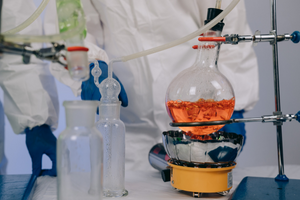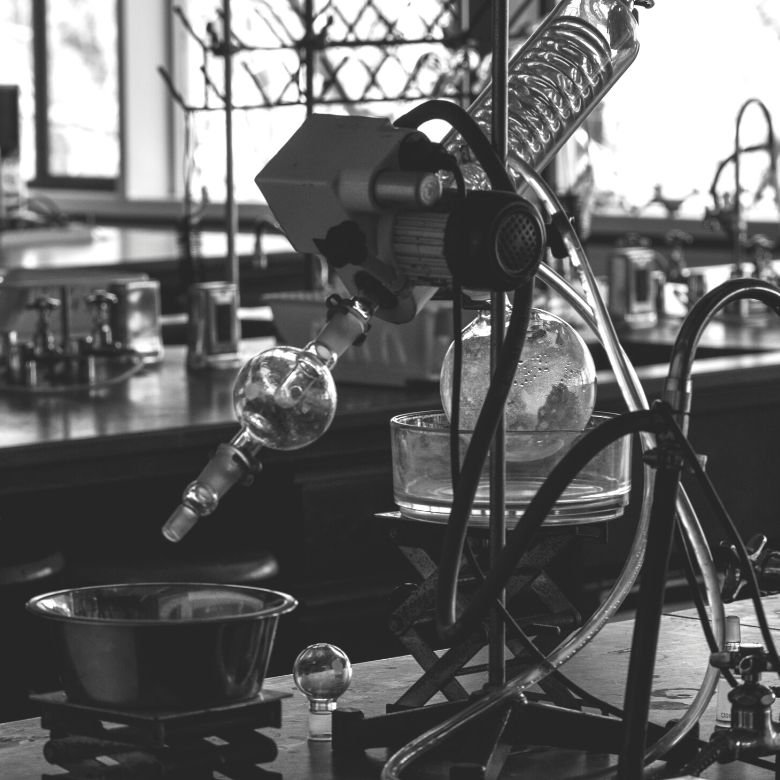The vast majority of substances that occur in our environment are mixtures. They consist of two or more components in different physical states. Taking into account the type of mixture and the physico-chemical properties of its components, various separation methods can be applied. The most important of them are presented below and briefly discussed.

Decanting and filtering
In particular cases, when a solid is poured into a solvent, it will not dissolve completely. This happens when we used too much of it (much more than is allowed by its solubility under given conditions) or its impurities turned out to be insoluble. In both cases, a suspension is obtained. To separate its components, physical methods such as decantation and filtration are used most often. They allow to obtain a clear filtrate free of solid particles or precipitate, which would be our desired product.
Decantation
Decantation consists in pouring out the liquid from above the sediment. In order to do so, the obtained suspension should be allowed to rest for a longer time so that the precipitate settles at the bottom of the vessel, e.g. a beaker. When this is done, the clear solution is carefully poured off. However, the sediment often contains a significant residue of the so-called mother liquid. In this case, you can again pour fresh solvent on the sediment and repeat the previous steps.
Filtration
The filtration process is often preceded by decanting, to shorten its time. In this method, the sediment is retained on a porous barrier, e.g. on a paper disc (filter). The solution that passes through its pores and is separated from the solid residue is the filtrate. Depending on the type of sediment (fine-grained, coarse, coarse-crystalline or flocculent), the appropriate filter material and permeability are selected. Gravity filtration is rarely used. In laboratory practice, filtration sets equipped with a pump are used, which significantly speed up the process.
Distillation
Simple distillation is used to separate homogeneous liquid mixtures. It consists in heating the solution to the boiling point. The individual components of the mixture begin to evaporate in accordance with the increasing boiling points (increasing volatility). The greater the difference in the boiling points of the individual components, the better the mixture can be separated. The vapours of the components go to a cooler. It is connected by rubber hoses to a cooling water source. The water flows through the cooler counter-currently. The cooled vapours condense and go into the receiver. Remember that before distilling a liquid mixture in glass set, put a few pieces of e.g. porous porcelain into the round-bottomed flask. This will prevent local overheating of the flask walls. In the distillation process, the following are distinguished:
- Miscible liquids – a liquid mixture that we want to separate by distillation. It is placed in the distillation flask.
- Distillate – it is the product of distillation.
- Reflux – a liquid formed as a result of steam condensation. It flows down the walls back into the flask.
- Fractions – these are successive parts of the distillate. Each fraction is a different component of the liquid mixture.
- Interfractions – liquid collected when the mixture heated in the flask exceeds the boiling point of the more volatile liquid, but has not reached the boiling point of the less volatile liquid. An interfraction is a mixture of distillates of both these liquids.
Rectification is a specific type of distillation. It consists in multi-stage distillation in the so called rectification column. The liquid and vapour meet in a counter-current, where heat and mass exchange takes place. Rectification requires the return of part of the condensate back to the distillation column.

Crystallisation
The crystallization method is used to isolate the solute from the solution. The first step will be to obtain a saturated solution, i.e. one in which no more substance can be dissolved (under given conditions). In this case, a good way will be to warm the solution. During this process, partial evaporation of the solvent will take place, and therefore its concentration will increase. Heating can be carried out until the first crystals of the substance (crystallization seeds) appear. The resulting hot, saturated solution is enough to be carefully cooled to start the crystallization process, i.e. the precipitation of crystals of the dissolved substance. This is a relatively time-consuming process. It requires slow crystal growth in the process of maturation. The gradual crystallization process promotes the formation of large crystals of high purity. The resulting crystals must be separated from the solution, i.e. mother liquid, by fluted funnel filtration using a vacuum filter set. It is also necessary to wash them to remove any solid impurities. Sometimes it is necessary to initiate crystallization the process, e.g. by throwing a crystal of the precipitated substance into a saturated solution or by mechanical induction (gently tapping the walls of the vessel with the solution).
Chromatography
Currently, chromatography is one of the most commonly used techniques for separating mixtures in laboratory practice. It is mainly divided into liquid, gas, mobile supercritical, ionic and paper chromatography. The first two of these are the most applicable.
Liquid chromatography
The central part of the liquid chromatograph system is a column filled with a bed on which the proper separation of the mixture components takes place. The tested substances are introduced together with the eluent, i.e. the mobile phase. The individual components of the mixture interact with the bed of the stationary phase with varying intensity. The greater this interaction, the stronger they are retained inside the column and the later they reach the detector. Substances that are not retained elute (wash out with the eluent) first, together with the mobile phase. The proper selection of chromatographic separation parameters, such as the type of bed, composition of the mobile phase, analysis time, temperature, etc., allows for selective and repeatable separation of mixtures.
Gas chromatography
The principle of separation of the components of a mixture in gas chromatography is identical to that in liquid chromatography. In this case, the fundamental change is the gaseous mobile phase (carrier gas). The analysed mixture in the form of a liquid solution is introduced into the dispenser, which is one of the elements of the gas chromatograph. This way it evaporates and is introduced to the chromatographic column together with the carrier gas. After separation in the column, the components go into the detector.
